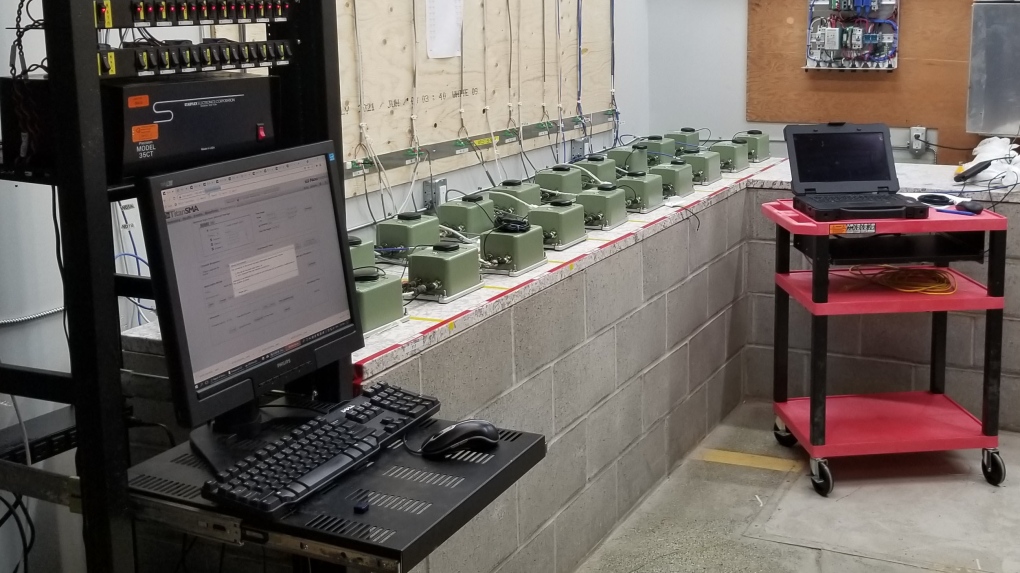Sensors to warn people of an earthquake installed in Ottawa area
 Damage from an earthquake is seen in this file photo.
Damage from an earthquake is seen in this file photo.
Ottawa residents will one day receive a three- to 10-second advance warning of an earthquake before the ground starts shaking.
Natural Resources Canada has been installing seismic sensors in the capital region over the past week that are part of the Earthquake Early Warning Network, designed to send out a notification through electronic devices before the strong shaking from the earthquake begins.
"What that does is it gives people the time to drop, cover and hold on, so that they can be prepared just before they start feeling that shaking," said Chris Boucher, Seismic Analyst with Natural Resources Canada.
 The TitanSMA seismic equipment in a lab at Natural Resources Canada in Ottawa. (Natural Resources Canada)
The TitanSMA seismic equipment in a lab at Natural Resources Canada in Ottawa. (Natural Resources Canada)
The Earthquake Early Warning Network will have 400 sensors installed in areas of earthquake risk across Canada, including in eastern Ontario. Boucher says the seismic sensors will detect the primary waves of an earthquake, which are very weak, and then send out the alert.
"So these network of stations, what it does is it quickly digitizes that information, sends it to our data centres, calculates the location and the magnitude of that earthquake and if it reaches a certain threshold of shaking, it will send out alerts to cellphones, TVs and radios before that secondary waves and strong shaking starts," Boucher told CTVNewsOttawa.ca.
In June 2010, a magnitude 5 earthquake in Val-des-Bois, Que. caused damage in parts of western Quebec, while rattling buildings and windows in downtown Ottawa. Natural Resources Canada says the Earthquake Early Warning Network would have given residents a three to 10 second warning for that earthquake.
Boucher says while a three to 10-second warning may not seem like a lot of time, it's enough time to make a difference.
“Sometimes that few seconds is all we really need to take those few steps of drop, hovering and holding on," Boucher said. "One thing to consider is that these automatic alerts would be going out to critical infrastructure, who can have automatic infrastructure in place.”
Boucher says a three to 10 second warning would be enough time to divert planes from landing at airports, close bridges and tunnels to traffic and pause surgeries in hospital operating rooms.
“Once the shaking starts these systems are ready.”
Natural Resources Canada says the further you are from the epicentre of the quake, the more warning time you will have.
Ottawa is part of the western Quebec seismic zone. Boucher says the region sees about 120 earthquakes a year, but only 10 or so are felt by people.
Seven seismic sensors have been installed in the Ottawa-Gatineau region so far, with plans for another 20. Natural Resources Canada says the Earthquake Early Warning System sensors have been set up in several locations, including Cumberland, Stittsville, Mississippi Mills, Kenmore and Carsonby. One has been installed in Kingston.
The Earthquake Warning System Network is scheduled to be operational in 2024.
CTVNews.ca Top Stories

opinion Tom Mulcair: Prime Minister Justin Trudeau's train wreck of a final act
In his latest column for CTVNews.ca, former NDP leader and political analyst Tom Mulcair puts a spotlight on the 'spectacular failure' of Prime Minister Justin Trudeau's final act on the political stage.
B.C. mayor gets calls from across Canada about 'crazy' plan to recruit doctors
A British Columbia community's "out-of-the-box" plan to ease its family doctor shortage by hiring physicians as city employees is sparking interest from across Canada, says Colwood Mayor Doug Kobayashi.
'There’s no support': Domestic abuse survivor shares difficulties leaving her relationship
An Edmonton woman who tried to flee an abusive relationship ended up back where she started in part due to a lack of shelter space.
opinion King Charles' Christmas: Who's in and who's out this year?
Christmas 2024 is set to be a Christmas like no other for the Royal Family, says royal commentator Afua Hagan. King Charles III has initiated the most important and significant transformation of royal Christmas celebrations in decades.
Baseball Hall of Famer Rickey Henderson dead at 65, reports say
Rickey Henderson, a Baseball Hall of Famer and Major League Baseball’s all-time stolen bases leader, is dead at 65, according to multiple reports.
Arizona third-grader saves choking friend
An Arizona third-grader is being recognized by his local fire department after saving a friend from choking.
Germans mourn the 5 killed and 200 injured in the apparent attack on a Christmas market
Germans on Saturday mourned the victims of an apparent attack in which authorities say a doctor drove into a busy outdoor Christmas market, killing five people, injuring 200 others and shaking the public’s sense of security at what would otherwise be a time of joy.
Blake Lively accuses 'It Ends With Us' director Justin Baldoni of harassment and smear campaign
Blake Lively has accused her 'It Ends With Us' director and co-star Justin Baldoni of sexual harassment on the set of the movie and a subsequent effort to “destroy' her reputation in a legal complaint.
Oysters distributed in B.C., Alberta, Ontario recalled for norovirus contamination
The Canadian Food Inspection Agency has issued a recall due to possible norovirus contamination of certain oysters distributed in British Columbia, Alberta and Ontario.


































